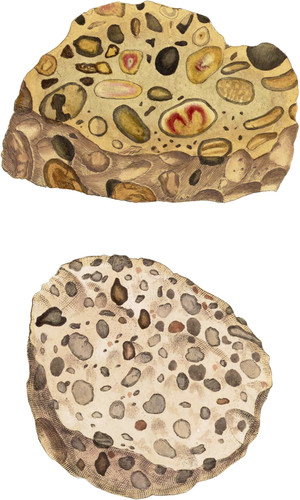 Enlarge
Enlarge
British Mineralogy
Quartzose Pudding Stone
- Class 2. Earths.
- Order 3. Aggregated.
- Gen. 2. Silex.
- Spec. 1. Quartzose.
- Syn.
- Pudding Stone. Kirw. v. 1. 360. Bab. 131.
- Quartz-agathe breche. Haüy, v. 4. 461.
- Poudding. R. De Lisle, v. 2. 481.
This is not rare, in gravel-pits, in many counties of England; Hertfordshire is however most famous for producing it. Pudding Stone is little known abroad, and is therefore esteemed in Germany, and other parts of the continent, as an English rarity. I believe it is not found either in Scotland or Ireland*.
The most perfect and most esteemed specimens are those which have the closest and finest siliceous cement, with the greatest number of variegated pebbles, sometimes with fanciful representations: see left hand part of the figure.
They are much the same in texture and hardness throughout, as the flint pebbles figured in tab. 88, and bear a polish equally well with them.
The upper figure is one of this sort, but is better in some parts than in others. The sides show an imperfection, as some of the pebbles are broken out, having been rather moulded than cemented, and almost loose when found. This specimen, I believe, is from Hertfordshire, where some people assert that they grow! This kind of stone was greatly sought after about a century ago, to be cut into trinkets, snuff-boxes, coat-buttons, &c.
The lower specimen came from South-end Essex, and was given me by Lady Wilson. The opposite shore, at Sheppy island, Kent, has many varieties of it, probably washed out of the curious marle clifts of that place. This specimen is somewhat too sandy, and not close-grained enough to bear a polish. They are sometimes found very large, and I have seen fragments of them that must have been several feet in diameter, which had been formerly worked into querns to grind corn.
Probably the name was given by English lapidaries; and, as Mr. Kirwan observes, they meant, by the appellation of Pudding Stones, to express flint pebbles of any colour cemented with a substance of the same or similar hardness, so as to make an equally compact stone for polishing.
- * Though in Scotland they call some of the rocks by this name.

